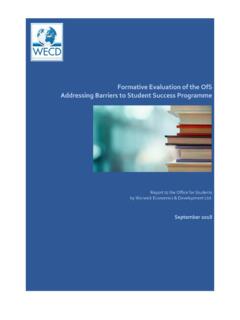Transcription of Condition B3: baselines for student outcomes indicators
1 Condition B3: baselines for student outcomes indicators Background 1. Condition B3 of the Office for Students' (OfS's) regulatory framework requires that: The provider must deliver successful outcomes for all of its students, which are recognised and valued by employers, and/or enable further study.'. 2. The Condition is assessed in two stages. The first considers the absolute outcomes delivered by the provider for its students. The second gives consideration of the context in which these outcomes are achieved. As we assess the Condition we also conduct a risk assessment to determine the risk of a provider breaching the Condition once it is registered.
2 Where our assessment shows an increased risk of a future breach of the Condition we can apply regulatory interventions, such as a specific Condition , to mitigate these risks. 3. This document primarily relates to the first stage of the assessment. It describes the indicators we constructed and used during the registration process, and explains how we established the relevant baselines against which providers were assessed in the first stage of the process and during our risk assessment. Further detail about how the Condition was assessed during the initial registration process and the mitigations that were applied in relation to Condition B3 can be found in Office for Students registration process and outcomes 2019-20'1.
3 indicators assessed during registration 4. The regulatory framework identified a range of student outcomes that would be considered for the purposes of assessing Condition B32: a. student continuation and completion. b. Degree outcomes , including differential outcomes for students with different characteristics. c. Graduate employment and, in particular, progression to professional jobs and postgraduate study. 5. We constructed the indicators based on individualised student data returned by providers to the Higher Education Statistics Agency (HESA) student record collections, or through the individualised learner record collected annually by the Education and Skills Funding Agency (ESFA) and its predecessors.
4 6. In large part, the indicators were constructed according to established methods which higher education providers would have some familiarity with. However, there were a small number of refinements to the detail of those methods, and we have documented the detailed 1 See 2 Paragraph 340 at framework-for-higher-education-in-englan d/. 1. methodology, algorithms and rebuild instructions for the indicators used in relation to Condition B3 to be transparent and to help providers understand these indicators3. 7. For each indicator described in paragraph 4 a-c above, the indicators were constructed to show a provider's performance in aggregate, over a time series (for the number of years up to a five year period for which indicators could be derived from available student data), as well as across split indicators '.
5 8. These split indicators ' showed the performance within each indicator broken down for students from different demographic groups in terms of students' age, participation of local areas (POLAR) quintile, English indices of multiple deprivation (IMD) quintile4, ethnicity, disability, sex and domicile. 9. In order to construct the maximum five year time series for each of the different indicators , the most recent eight years of student data returns were required5. This means that the initial construction of the indicators in spring 2018 drew on data returns for 2009-10 to 2016-17. 10. The indicators are updated annually in around March of each year to incorporate the most recent year of student data once it has become available.
6 Providers still in the registration process in March 2019 were assessed using updated indicators which were constructed from data collected from 2010-11 to 2017-18. 11. As set out in the sector B3 workbook, whether in aggregate, over a time series or across the split indicators ', all of the indicators were shown separately for each mode of study (full or part- time). The continuation and graduate employment or postgraduate study indicators were also broken down to show outcomes at different levels of study as follows: a. Other undergraduate6. b. First degree c. Undergraduate course with postgraduate elements7. d. Other postgraduate e. PGCE.
7 3 Available at: Information on the core algorithms is also available: b423f7bff69 4. For POLAR and IMD, the aggregation of quintiles 1 and 2 is shown separately to the aggregation of quintiles 3, 4 and 5. 5 This is because construction of the student continuation and completion indicators described in paragraph 2a involves tracking individual students within and across consecutive years of student data to make a robust assessment of their outcomes . For example, the continuation rates for part-time students starting higher education courses in 2015-16 are derived from student data for the period 2014-15 to 2017-18. 6 This level of study is not included in the assessment of graduate employment or postgraduate study indicators for the reasons explained in paragraph 23.
8 7 Examples of undergraduate course with postgraduate elements include: integrated undergraduate/postgraduate taught masters degrees on the enhanced/extended pattern; pre-registration medical degrees regulated by the General Medical Council; pre-registration dentistry degrees regulated by the General Dental Council; and other graduate or postgraduate diplomas, certificates or degrees at levels 5. and 6 where a level 5 or 6 qualification is a pre-requisite for course entry. 2. f. Postgraduate taught masters g. Postgraduate research. Establishment of baselines 12. For each indicator we established baselines that indicate whether performance was likely to be of: no concern concern significant concern.
9 13. The baselines for each indicator vary according to the mode and level of study as set out in Tables 1 to 3. 14. The baselines were determined by making a judgement about what an appropriate minimum level of performance should be. 15. The significant concern' baselines for each indicator took account of differential performance between demographic groups. We considered a wide variety of data on this issue including sector level trends published by the OfS and the Higher Education Funding Council for England8, as well as analysis contained in the equality impact assessment for the regulatory framework9. 16. We also decided that it was important to consider not only the performance against the significant concern baseline established for each indicator, but also how widespread any instances of performance that were of significant concern' were within the provider's student population.
10 The inclusion of the demographic split indicators ' helped this understanding, allowing us to see how the provider's performance applied to different demographic groups, and to calculate the proportion of the most recent student population that fell into demographic groups where performance was of significant concern'. 17. We decided that if 75 per cent or more of a provider's students fell into demographic groups with at least one outcome of significant concern', then Condition B3 would be unlikely to be satisfied (although we would then consider other relevant factors, including the context in which a provider operates). 18. In adopting 75 per cent as the relevant baseline for the initial consideration of whether the Condition was likely to be satisfied (before taking into account the context of the provider), we had regard to the fact that Condition B3 requires that a provider must deliver successful outcomes for all of its students.











